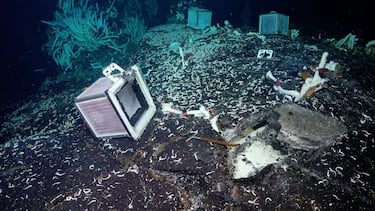Discovery beneath the Earth’s crust: ‘There are worms over a foot and a half long’
Over 8,000 feet down in the deep ocean, researchers have found life in incredible places.

“A new ecosystem.” That’s how a team of scientists described an extraordinary recent discovery, which took place over the summer and has now been shared in the journal Nature Communications. Led by marine biologists Monika Bright and Sabine Gollner, the team explored the Pacific depths with the help of SuB-astian, a remotely operated submarine.
While the researchers were aboard the Schmidt Ocean Institute’s research vessel Falkor, managing operations from above, SuB-astian was busy documenting something unprecedented: the existence of animal life beneath the seafloor, below the Earth’s crust. “There are worms, snails, and chemosynthetic bacteria,” explain the biologists.explain.

Life in the most extreme places on planet Earth
The site of this discovery lies under hydrothermal vents caused by the Earth’s magma along the East Pacific Rise, one of the planet’s most extreme environments, where many experts believe life on Earth may have originated. Their explorations took place more than 8,200 feet down, on a submarine ridge about 5,600 miles long, known as the Albatross Ridge.
“This discovery of a new ecosystem, hidden beneath another, provides fresh evidence that life exists in incredible places,” the study authors note. Using a robotic arm equipped with a chisel, the submarine was able to extract several sections of the Earth’s crust, revealing the unexpected life forms beneath. “The cavities were filled with warm fluids and contained all kinds of animals, including tube worms over a foot and a half long,” explains Gollner.
The location of the find is a volcanically active zone between two tectonic plates on the Pacific Ocean floor. As the plates collide, they often create high-temperature magma upwellings. In some cases, this magma meets ocean water, forming hydrothermal vents, where the extreme cold of the deep sea mixes with extreme heat, triggering chemical reactions.
A new vision of the seabed
Previous research had confirmed the presence of living organisms near these hydrothermal vents, but not beneath the crust itself. Until now, this had remained a hypothesis, lacking confirmation. But now, it’s been confirmed, documented, and recorded. Among the organisms discovered are giant tube worms (Riftia pachyptila), which live in colonies at great depths.
Related stories
“The discovery of new creatures, landscapes, and now, an entirely new ecosystem highlights how much we still have to uncover about our oceans, and how crucial it is to protect what we don’t yet know or understand,” says Wendy Schmidt, president and co-founder of the Schmidt Ocean Institute. She also emphasizes the importance of “fully exploring our oceans to discover what exists in the deep sea.”
Original article by Raúl Izquierdo, translated with the assistance of AI and edited by David Nelson.
Complete your personal details to comment